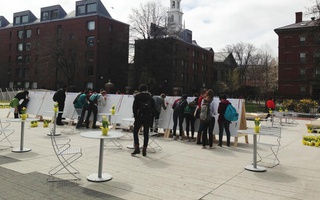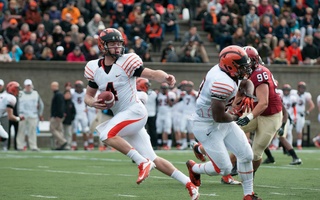An image: two modern, striated towers, set like silhouettes against a deep, azure sky; sharp flames chalked with smoke, rending and severing the morning and its lives and inspiring the somber echo—we will never forget.
That refrain, a commitment to remembrance, extends backward well beyond 2001. In the nineteenth-century, “Remember the Alamo” spurred on Texan soldiers. In 1863, Lincoln famously declared of the Gettysburg dead—the world “can never forget what they did here.” In Britain, voices have hummed a centuries-old rhyme, to “remember the fifth of November.”
Strangely, then, the date of September 17, which passed on Monday, is not a day that often captures national attention. But it is a day that should. Another image: a flat, trampled, ruddy cornfield, and farther south a pure, white, wooden church (fully out of place), and then a sanguinary, sunken lane-turned-grave, and finally a triple-arched stone bridge across a winding creek.
That is a view of the area around Sharpsburg, Maryland, on Antietam Creek, in the aftermath of the United States’ single bloodiest day: September 17, 1862. This week marks its sesquicentennial, or 150-year anniversary. One hundred and fifty years ago, this week, the Union’s Army of the Potomac launched a day-long, cumbersome, rolling assault that at once both failed to shatter General Robert E. Lee’s scattered Army of Northern Virginia and offered enough of a victory to stave off foreign, pro-South intervention, and to allow Lincoln breathing room for his Proclamation. The battle’s 23,000-plus American casualties have never been surpassed on any date in American history—a crude and unwelcome claim to fame.
Despite the day’s tragic status, our remembrance seems to belie Lincoln’s words at Gettysburg: “The world will little note, nor long remember what we say here, but it can never forget what they did here.” In fact, Lincoln’s words are the stuff of movies and monuments, and the sacrifices’ substance, from our nation’s bloodiest days, garners less acute attention. Is this lamentable? For most of us, reflexively, the answer is yes—we ought to try harder. But the question begets broader ones: What value does memory of these sacrifices confer? What does it mean to “never forget”? And why remember at all?
Maybe a commitment to remember, whether for September 11 or September 17, is for the benefit of the dead. The urge to be remembered is certainly a common refrain (a driver of tombstone epitaphs and monument inscriptions), but memory’s value to the departed can probably fit a less supernatural scope, too. Maybe remembrance is utterly pragmatic—to fuel desire for revenge or justice. For instance, Union soldiers at Gettysburg shouted “Fredericksburg” as they cut down Lee’s last charge, evoking the memory of their own wrecking at Fredericksburg, Virginia, seven months earlier. And the post-9/11 U.S. response involved a similar impulse. “Justice has been done,” President Obama declared at the death of Osama Bin Laden. But that notion has little to offer a 2012 recollection of 1862.
Even without articulating a goal for remembrance, however, we can still make two vital observations. First, remembering is not easy. In his Booker Prize-winning novel, “The Sense of an Ending,” which revolves around memories, author Julian Barnes writes, “Time doesn’t act as a fixative, rather as a solvent.” As years pass, specific memories bleed together and decay. But Barnes is talking about recalling a life. Recalling a generations-old event presents a still steeper task, which demands a deep, conscious effort. And second, historical memory is not something to be taken for granted. Not after the recollection of Antietam’s war was co-opted by a “lost cause” mythology, in turn abetted by a North too willing to forget. Not after the widespread suppression of historical truths—of collective memory—orchestrated by regimes in the Soviet Union, China, Nazi Germany, and elsewhere. Czech writer Milan Kundera pithily described the mechanical proliferation of Vladimir Lenin statues: “Lenin statues have sprouted up by the thousands. They grow like weeds on the ruins, like melancholy flowers of forgetting.” We do not have a political regime fixed on “melancholy flowers,” or a culture committed to misremembering, but we do face our own lassitude. Lincoln, in his speech, presumed a truth that needs restating: “Never forget” is not a platitude.
Back to the question at hand: why remember, and how? Memory of the losses 150 years ago, or 11 years ago, or the many years between and beyond, is, at its core, about responsibility—not just to a prior generation, but to ourselves and our current nation, products of the indelible past. It’s about orienting the present and future in light of the past, in light of the 3,650 dead at Sharpsburg, Maryland, or the countless other lives destroyed or altered on days like it. The 1998 World War II movie, Saving Private Ryan, includes a scene near its end that sums up this idea with more force than any string of logic.
A final image: a battered French town, planes growling through the afternoon sky—this sky is all grey haze—as Tom Hanks’ Captain Miller, moments from death, gasps out four, barely audible words for Private Ryan, whom the captain and his men have died to save: “Earn this. Earn it.”
Brian L. Cronin, ’15, a Crimson editorial writer, lives in Mather House.
Read more in Opinion
A Courageous CareerRecommended Articles
-
Call That a Vigil?The Harvard community seemed to use the anniversary primarily as a means of decrying post-9/11 discrimination in America and the subsequent foreign policy of the Bush administration.
-
Politics and RemembranceSeptember 11th was not Gettysburg. The soldiers Lincoln eulogized were not civilians; Civil War adversaries were better-defined and perhaps better understood than those in a war of terror.
-
 Why the Daffodils?
Why the Daffodils? -
Clear Blue SkiesToday, we can all be New Yorkers—proud, strong, and never forgetting.
-
 Four Dollar Wine Critic: AMERICA!
Four Dollar Wine Critic: AMERICA! -
 Around The Ivies: Plot Twists Ahead
Around The Ivies: Plot Twists Ahead













